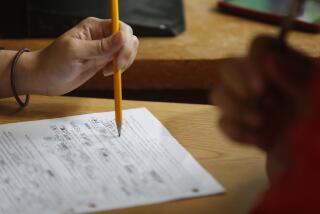Richard F. Thompson dies at 84; USC scientist traced physical aspects of memory
More than a century ago, Ivan Pavlov showed he could make trained dogs salivate when they heard a bell, invoking the memory of food.
But it wasn’t until the 1980s that USC neuroscientist Richard F. Thompson cracked the mystery of how those types of memories are physically formed and “hard-wired” into the brain.
It was a landmark discovery that was controversial at the time, but over the next 20 years Thompson’s work in tracing the physical aspects of memory became widely accepted.
“We talk about exploring outer space,” Larry Squire, professor of neuroscience and psychology at UC San Diego, said in an interview with The Times. “Dick Thompson explored our inner universe.”
Thompson, 84, died Sept. 16 at his home in Nipomo, Calif., said his daughter, Virginia Thompson-DeWinter. He had been suffering from congestive heart failure and had a recent fall.
Instead of dogs and bells, Thompson did much of his research into memory with rabbits and electronic beeps. He would make a beep sound, then about half a second later release a small puff of air on the rabbit’s eye, causing the animal to blink.
After numerous repetitions, just the beep sound, without the air, would make the rabbit blink. Neuroscientists call this a conditioned response, and once learned it is not forgotten.
Thompson suspected the air puff memory was stored in the rabbit’s cerebellum, the part of the brain that controls motor functions.
He proved his findings by surgically removing a small amount of brain tissue from the area he believed harbored the memory. Afterward, the rabbit no longer blinked when the beep was sounded. In fact, though the rabbit could still blink normally, the conditioned response could not be learned again.
Thompson worked with psychobiologist William Greenough of the University of Illinois to show that these types of memories made a physical change in the brain.
“Once you learn a conditioned response, you somewhat modify the circuits in that part of the brain,” said Stephen Madigan, an associate professor of psychology at USC who with Thompson co-wrote the 2005 book “Memory: The Key to Consciousness.”
Thompson and Greenough, who died last year, presented their findings at a 1989 Society for Neuroscience meeting. Some scientists questioned their work because it was generally thought that the cerebellum was not involved in harboring these kind of memories.
But Thompson’s further research confirmed that they were indeed housed in a tiny part of the cerebellum — the section he altered to take away the conditioned response.
His work was pure science and had no practical applications. But that could change in time.
“It’s the kind of work that often leads to medical advances,” said Squire, who also is on staff at the Veterans Affairs Medical Center in San Diego.
“Before we fix the car, we have to know how the car works.”
Richard Frederick Thompson was born Sept. 6, 1930, in Portland, Ore. He earned his bachelor’s degree in psychology at Reed College in that city, then his master’s and doctorate at the University of Wisconsin-Madison.
He taught at Harvard and Stanford before arriving in 1987 at USC, where he developed the neuroscience research program.
In 2010, Thompson received an American Psychological Foundation’s Gold Medal for life achievement. At that point he was still active at the university.
“I’ll be 80 this year, so I’m not sure how much more research I’ll be doing,” he said. “Right now, we’re wrapping up a major project going on for 30 years, identifying the places in the brain where memories are stored.” Thompson retired later that year.
In addition to his daughter Virginia, he is survived by his wife of 54 years, Judith Thompson; his daughters Kathryn Thompson-Clancy and Elizabeth Collins; and seven grandchildren.
david.colker@latimes.com
Twitter: @davidcolker
More to Read
Start your day right
Sign up for Essential California for the L.A. Times biggest news, features and recommendations in your inbox six days a week.
You may occasionally receive promotional content from the Los Angeles Times.







